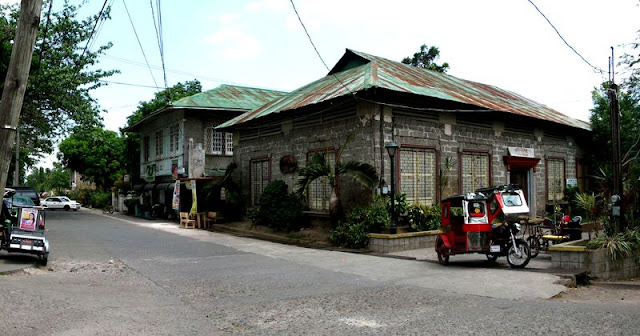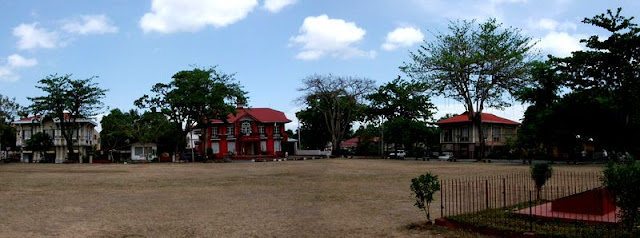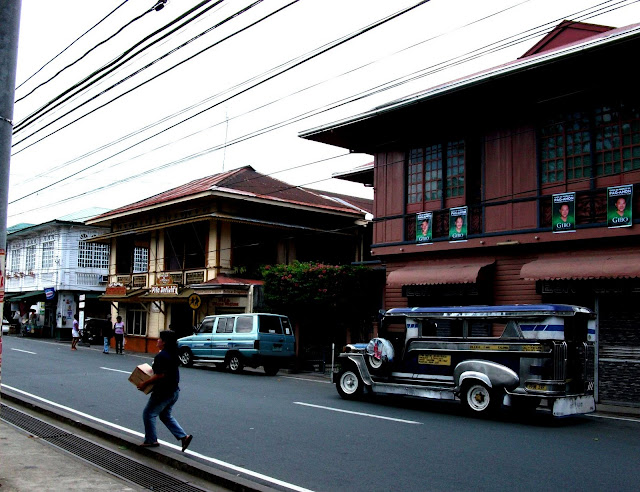Conservation
There are many towns around the country that are struggling to keep their heritage structures. Its common to see churches in disrepair, if not recklessly renovated. Ancestral houses are sold – not because of its architectural value but because of the land beneath it. These houses stands on what realtors consider prime lots.
Pila has dealt with these conservation issues and found solutions.
Around the Pila, one could notice how the original Spanish era layout that has basically remained intact. Pileño’s communally coordinate and organize their efforts in maintaining their heritage structures. They could boasts having one of the most intact filhispano town in the country today. In this category, two other towns comes to mind, Vigan and Carcar.

Escuela Pia. What could probably be the oldest standing structure.

From left to right: Dn Lorenzo Rivera house, Municipal Hall & Dna. Corozan Rivera

From left to right, the houses of: Dn. Inigo Rivera, Dn. Vicente Mendoza, Dn. Clemente Santiago, Dn Paciente Agre
How they accomplished this is not a guarded secret. Their attitude towards the preservation of their cultural heritage is among the most dedicated I’ve ever seen. When tarpaulins and banners are banned in the town plaza. They’re dead serious when it comes to heritage conservation.
There’s a sense of ownership among Pileños. People draw pride and satisfaction from their involvement in maintaining what they inherited. I saw an old photo of Pila (circa 1890’s) and the town then looks exactly the same as it is today.
Pila Antigua
Pila was given the honorific title “villa” which was reserved for the rich and culturally avant-garde communities in Spanish Philippines. Sadly, most of the Villas has failed to retain its old character. Among the eight Philippine Villa’s, only Pila and Vigan succeeded in maintaining the original town layout and the important bahay na bato’s.
Pila could provide us with the blueprint on how to salvage what’s left of our old towns without needing big money. When conservation is the discussion, individuals and groups always talk about money – but I feel that attitude is as important as funding. The people must be taught of the importance of why there’s a need to conserve. Although the church and plaza had received several donations from known politicians, the houses were largely maintained by descendants.

Closer look

The houses are perfect examples of "reuse" architecture
I hope that someday the people of Pila would have a guided tour of the town. I’m sure some individuals has done it before but it must be sustained to attract more tourist. Filipinos can learn a thing or two from them.
The Spanish Speaking Pileños
I remember this conversation I had with a friend about Spanish as a language to Filipinos. I believe that there’s little we can achieve if Filipinos speaking Spanish increases but we neglect to study its historical relevance. I’ve met people who are so fluent in Spanish that they embarrass me to try mine. But as good as they are in speaking it, they could not relate the language to their identity. Instead, these people ends up loving the culture of Spain and not that of the Filipinos who once spoke it.
Filipinos today are conditioned to accept that Spanish was never a Filipino language. But you know, there was a generation of Filipinos that treasured this language so much that they (and their families) had their lapidas (memorials) dedication in Spanish. We need not only appreciate the tradition in Spanish but also understand it.
The lapidas with dedications inside San Antonio de Padua are no different from the ones you normally see in old churches but something called my attention while I was looking at them. Some of them died just decades ago. These Pileños are probably last remaining Spanish speakers. I’m not sure if the generation that succedded them learned Spanish from them. I would be least surprised if they did.
Some of the well known Pileño families in Pila are: the Rivera’s, the Relova’s, the Noroña’s, the Villarica’s and the Dimaculangan’s.
The prefilipino Pila
Even before the consolidation of all islands into one state, Pila, was believed to be a thriving settlement. Excavations in the 60’s had proven this. The town is proud to have saved this part of their history. The old Escuela Pia at the left side of the church, now house some of the most important archeological finds in Pila.
Among ancient practices that I find interesting is the practice of cremation among the natives in prefilipino Pila (Pinagbayanan). This particular burial practice was first recorded in Sabah. Such discoveries proves that we are linked not only by blood but also by traditions with the ancient Malay people.
The Renovated Church
The misconception is that if you paint and renovate a stone church, you are desecrating it – quite the contrary. If done properly, restoration works prolong and strengthen the structural integrity of a building. San Antonio de Padua is a perfect example of this.
They haven’t changed anything in the church but they reconstructed areas keeping the old design in mind. The original church was built in the early 1600’s but was later transferred due to frequent flooding in 1800 (taking the town with it). The present church was finished in mid 1800’s and like all the other churches in islands, suffered some damaged during the great earthquake of 1880–the bell tower collapsed and had to be rebuilt — a certain Fray Lope, reconstructed the tower.

The church and its former convent (now a school).

One of the best restoration I've ever seen.

A shining example
Under the bell
I suggest for visitors to go to the bell tower (of course, with the permission of the authorities). It can be accessed by entering the stairs on the left side. This then leads to the choir loft. From there, another stair, this time narrower. Be careful because there are lots of bats here — they can bite and poop on you. Bats made the tower their home. From up here one could appreciate the town’s beauty – a beauty fast diminishing in our homeland.
—-



January 8th, 2016 at 7:00 am
Hello! may i know what are the benefits you gain from your travel in cultural site in pila. I hope youll answer. thankyou and GOD BLESS! smile emoticon
January 8th, 2016 at 7:04 pm
I learned something really important in Pila Christal. That is that church, local government and families can all work together to maintain a town’s heritage. It can be done. Pila is proof.
January 8th, 2016 at 6:59 am
Hello! may i know what are the benefits you gain from your travel in cultural site in pila. I hope youll answer. thankyou and GOD BLESS!
January 8th, 2016 at 6:57 am
Hello! may i ask what are the benefits you gain from your travel in cultural sites of Pila? Im researching about this. i hope you’ll answer. GOD BLESS!
July 18th, 2012 at 3:06 am
Wow! I’m proud to be a pileño..
December 5th, 2011 at 8:09 pm
Nice piece of writing about one the last remaining hispano filipino towns!
October 25th, 2011 at 3:10 pm
Love the houses in this town! Mabuhay ang bayan ang Pila!
October 1st, 2011 at 2:58 pm
How wonderful they did with these houses! Greetings from Madrid!
September 25th, 2011 at 8:28 am
Grew up in nearby Victoria town but we go here to attend church. Thx for this.